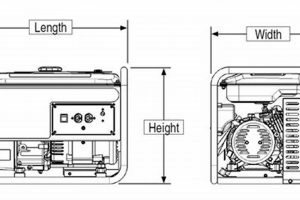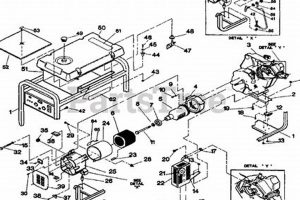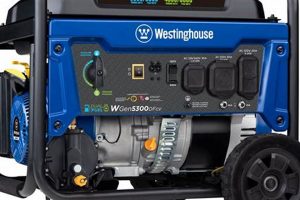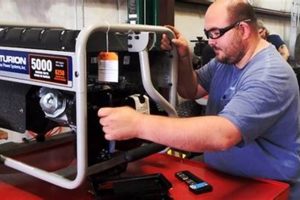Occupational Safety and Health Administration (OSHA) guidelines for portable generators emphasize safe operation to prevent hazards like carbon monoxide poisoning, electrocution, and fire. These regulations provide comprehensive guidance covering aspects from generator placement and grounding to fuel handling and maintenance. For instance, OSHA standards mandate adequate ventilation when running a portable generator, specifically prohibiting its use indoors or in partially enclosed spaces.
Adherence to these safety standards is critical for protecting workers and the public. Such regulations contribute significantly to reducing workplace incidents and fostering safer environments. Historically, the need for stringent guidelines became evident as the widespread use of portable generators led to a rise in preventable accidents. These regulations evolved to address these emerging risks, ensuring both worker safety and public well-being.
The subsequent sections will delve into specific OSHA requirements for portable generator operation, covering topics such as proper grounding procedures, approved fuel containers, and recommended maintenance schedules. Furthermore, the discussion will expand on the potential hazards associated with improper generator use and strategies for effective risk mitigation.
Portable Generator Safety Tips
Safe operation of portable generators requires diligent adherence to established safety protocols. The following tips highlight essential practices for minimizing hazards and ensuring user well-being.
Tip 1: Operate Outdoors Only: Generators should always be placed outdoors, far from windows, doors, and vents. Never operate a generator inside a home, garage, basement, crawlspace, or other enclosed or partially enclosed area, even with ventilation.
Tip 2: Carbon Monoxide Precautions: Install battery-operated carbon monoxide alarms outside sleeping areas and on every level of the home. Test alarms regularly and replace batteries as needed.
Tip 3: Proper Grounding: Ground the generator according to manufacturer instructions. A properly grounded generator protects against electrical shock.
Tip 4: Dry Operation: Keep the generator dry and operate on a dry surface. Protect it from rain and other sources of moisture.
Tip 5: Fuel Handling: Turn off the generator and allow it to cool completely before refueling. Store fuel in approved containers, away from the generator and any ignition sources.
Tip 6: Electrical Connections: Never connect a generator directly to a home’s wiring. Use a transfer switch installed by a qualified electrician to prevent backfeeding, which can endanger utility workers and neighbors.
Tip 7: Maintenance: Follow the manufacturers recommendations for maintenance schedules. Regular maintenance ensures optimal performance and safety.
Tip 8: Inspection Before Use: Inspect the generator before each use. Check for damage, loose connections, and fuel leaks.
Adhering to these guidelines will significantly reduce the risks associated with portable generator operation. Proper usage not only safeguards individuals but also ensures equipment longevity and efficient power delivery.
By incorporating these safety practices, one can confidently utilize portable generators while minimizing potential hazards and ensuring both user and public safety.
1. Ventilation
Proper ventilation is paramount in portable generator safety, as mandated by OSHA. Generators produce carbon monoxide (CO), a colorless, odorless, and poisonous gas. Without adequate ventilation, CO can accumulate rapidly, posing a serious health risk, even leading to fatalities. OSHA regulations emphasize this critical aspect to prevent CO poisoning related to generator use.
- Open-Air Operation
OSHA standards dictate that portable generators must operate exclusively outdoors in well-ventilated areas. Positioning generators away from buildings, doors, windows, and vents ensures adequate airflow and prevents CO from entering enclosed spaces. Operating a generator inside a garage, even with the door open, represents a hazardous scenario due to restricted airflow and potential CO buildup.
- Distance from Openings
Maintaining a safe distance between the generator and any building openings, such as windows, doors, and vents, is crucial. This separation minimizes the risk of CO entering occupied spaces, even with air currents. Recommendations typically suggest a minimum distance of several feet to ensure effective CO dispersion.
- Monitoring CO Levels
OSHA recommends using CO alarms in areas where individuals may be present, even outdoors near a running generator. These alarms provide an early warning system for CO buildup, allowing for prompt evacuation and preventative measures. Regular testing and maintenance of CO alarms are essential for reliable operation.
- Awareness of Wind Direction
Wind direction plays a significant role in CO dispersion. Positioning the generator downwind of occupied areas minimizes the risk of CO being carried towards individuals. Assessing wind direction before operating a generator helps optimize ventilation and safety.
Understanding and implementing these ventilation guidelines, as outlined by OSHA, are crucial for safe portable generator operation. Neglecting proper ventilation can lead to dangerous CO accumulation, jeopardizing health and safety. Adherence to these practices significantly reduces the risk of CO poisoning and ensures a safe operating environment.
2. Grounding
Grounding represents a critical safety measure in portable generator operation, mandated by OSHA regulations to prevent electrocution hazards. A properly grounded generator directs stray electrical currents safely into the earth, protecting individuals from potentially fatal shocks. Understanding and implementing proper grounding procedures is essential for safe generator use.
- Preventing Electrical Shock
Grounding provides a low-resistance path for fault currents to flow into the earth, preventing them from passing through individuals. Without proper grounding, contact with a faulty generator can result in severe electrical shock. This safety mechanism protects against both direct contact with live parts and indirect contact through conductive materials.
- Stabilizing Voltage
Grounding helps stabilize voltage levels during operation, reducing the risk of power surges that can damage sensitive equipment connected to the generator. This voltage stabilization contributes to both personnel safety and the protection of connected devices.
- Methods of Grounding
OSHA standards specify acceptable grounding methods, typically involving a grounding rod driven into the earth and connected to the generator frame. The grounding rod provides a direct path to the earth, ensuring effective fault current dissipation. Specific grounding requirements may vary based on local electrical codes and generator specifications.
- Inspection and Maintenance
Regular inspection and maintenance of grounding components are crucial for ensuring continued safety. Corrosion, damage, or loose connections can compromise the grounding system’s effectiveness, increasing the risk of electrical hazards. Periodic checks and necessary repairs are vital for maintaining a reliable grounding system.
Proper grounding, as outlined in OSHA guidelines, is not merely a recommendation but a critical safety requirement for portable generator operation. Neglecting proper grounding significantly elevates the risk of electrocution and other electrical hazards. Adherence to these standards is paramount for safeguarding personnel and equipment during generator use.
3. Fuel Handling
Safe fuel handling practices are integral to portable generator safety, as emphasized by OSHA regulations. Improper fuel handling presents significant fire and explosion hazards, posing risks to both individuals and property. OSHA guidelines address key aspects of fuel handling to mitigate these potential dangers.
Fueling a hot generator creates an immediate fire hazard. Flammable vapors can ignite when exposed to hot surfaces or sparks. OSHA mandates allowing the generator to cool completely before refueling. This precaution minimizes the risk of vapor ignition and subsequent fire or explosion. A real-world example includes incidents where individuals refueling hot generators have experienced flash fires, resulting in severe burns and property damage. Spilled fuel, particularly near a hot engine, can likewise ignite readily, highlighting the importance of cautious fuel handling.
Storing fuel safely is another critical component. OSHA guidelines recommend using approved fuel containers and storing them away from ignition sources and the generator itself. Improperly sealed containers can release flammable vapors, increasing the risk of fire or explosion. Storing fuel in close proximity to a heat source, such as a running generator or a furnace, further elevates the risk of ignition. Practical application of these principles involves designating a dedicated fuel storage area, away from any potential ignition sources, and using only approved, properly sealed containers. These measures minimize the risk of accidental fires and explosions, protecting both individuals and the surrounding environment.
Adherence to OSHA guidelines regarding fuel handling significantly mitigates fire and explosion hazards associated with portable generator use. Understanding the potential dangers of improper fuel handling, exemplified by real-world incidents, underscores the practical significance of these safety measures. Implementing safe fuel storage and refueling practices ensures a secure operating environment and reduces the risk of accidents.
4. Connections
Safe electrical connections are crucial for portable generator safety, as highlighted by OSHA regulations. Improper connections can lead to backfeeding, electrocution, and fire hazards. Understanding and implementing correct connection procedures is essential for compliance with OSHA standards and ensuring user safety.
- Transfer Switches
OSHA emphasizes the use of transfer switches for connecting a generator to a home’s electrical system. A transfer switch isolates the generator from the utility grid, preventing backfeeding. Backfeeding occurs when electricity from the generator flows back into the power lines, energizing downed lines and posing a lethal threat to utility workers. Transfer switches eliminate this risk, ensuring the safety of both utility personnel and the public. Real-world incidents involving electrocutions of linemen due to backfeeding underscore the critical role of transfer switches in safe generator connection.
- Direct Connections (Prohibited)
Directly connecting a generator to a home’s wiring, often through a regular outlet, is strictly prohibited by OSHA. This practice bypasses safety mechanisms and creates a significant backfeeding hazard. It also poses risks of overloading household circuits and causing fires. Documented cases of fires originating from improper generator connections highlight the dangers of this practice. OSHA regulations explicitly forbid direct connections to protect both individuals and property.
- Extension Cord Safety
When using extension cords with portable generators, OSHA recommends heavy-duty, outdoor-rated cords specifically designed for generator use. These cords should be inspected regularly for damage, and connections should be kept dry and secure. Using inadequate extension cords or damaged cords can lead to overheating, fire hazards, and electrical shocks. Examples include incidents where overloaded or damaged extension cords have caused fires during generator operation. OSHA guidelines emphasize proper cord selection and maintenance to mitigate these risks.
- Qualified Electrician Installation
OSHA strongly recommends that transfer switches and other generator connections be installed by a qualified electrician. Proper installation ensures compliance with electrical codes and minimizes risks associated with improper wiring. A qualified electrician possesses the expertise to assess the specific electrical requirements, select appropriate components, and install the system safely and correctly. Attempting to install a transfer switch without proper training and knowledge can lead to hazardous wiring errors and potential safety breaches.
Adhering to OSHA guidelines for generator connections is fundamental for ensuring electrical safety. Proper use of transfer switches, avoidance of direct connections, safe extension cord practices, and professional installation contribute significantly to minimizing risks of backfeeding, electrocution, and fire hazards. These practices not only ensure compliance with OSHA regulations but, more importantly, safeguard individuals and property during generator operation. Neglecting these connection procedures can have severe consequences, as demonstrated by real-world incidents, underscoring the importance of adherence to safety standards.
5. Carbon Monoxide
Carbon monoxide (CO) poisoning presents a significant hazard associated with portable generator operation, a critical concern addressed by OSHA regulations. Understanding the properties of CO and the risks it poses is fundamental to ensuring safe generator use and compliance with OSHA standards. CO is a colorless, odorless, and tasteless gas produced by the incomplete combustion of fuels, including gasoline, propane, and natural gas. Its insidious nature makes it difficult to detect without proper monitoring equipment, increasing the risk of unintentional exposure and poisoning.
- Health Effects of CO Exposure
CO interferes with the body’s ability to absorb oxygen, leading to a range of adverse health effects. Mild exposure can cause headaches, dizziness, nausea, and fatigue. Higher concentrations can result in confusion, loss of consciousness, and ultimately, death. Real-world examples include cases of individuals experiencing CO poisoning while using generators indoors or in poorly ventilated areas, often resulting in hospitalization or fatalities. OSHA emphasizes the severity of CO poisoning and mandates specific precautions to prevent exposure during generator operation.
- CO Detection and Alarms
OSHA guidelines recommend installing CO alarms in areas where generators are operated, even outdoors. CO alarms provide a crucial early warning system, alerting individuals to the presence of CO and allowing for prompt evacuation and preventative measures. Regular testing and maintenance of CO alarms are essential for ensuring their reliable operation. Examples include instances where CO alarms have alerted individuals to dangerous CO levels, enabling them to escape potentially fatal situations. These real-world scenarios highlight the life-saving potential of CO alarms in the context of generator safety.
- Ventilation as a Primary Control Measure
Proper ventilation serves as the primary control measure for mitigating CO hazards associated with portable generators. OSHA mandates operating generators outdoors in well-ventilated areas, away from buildings and openings. Adequate airflow disperses CO, preventing its accumulation to dangerous levels. Cases where individuals have suffered CO poisoning due to inadequate ventilation underscore the importance of adhering to OSHA’s ventilation guidelines. These regulations emphasize the critical role of ventilation in minimizing CO exposure during generator use.
- Symptoms of CO Poisoning and First Aid
Recognizing the symptoms of CO poisoning is crucial for prompt intervention. Symptoms can range from mild headache and dizziness to severe confusion and loss of consciousness. If CO poisoning is suspected, immediately move the affected individual to fresh air and seek medical attention. Administering oxygen, if available, can be a life-saving measure while awaiting professional medical assistance. Real-world examples include situations where quick recognition of CO poisoning symptoms and prompt first aid have prevented fatalities. Understanding these symptoms and appropriate first aid procedures is vital for mitigating the severe health consequences of CO exposure.
The dangers of CO poisoning underscore the critical importance of adhering to OSHA’s safety guidelines for portable generator operation. Proper ventilation, CO alarm installation, and awareness of CO poisoning symptoms are crucial for mitigating the risks associated with CO exposure. These precautions, mandated by OSHA, protect individuals from the potentially fatal consequences of CO poisoning during generator use. Real-world incidents serve as stark reminders of the serious health risks associated with CO exposure and reinforce the importance of prioritizing safety and compliance with OSHA regulations.
Frequently Asked Questions
This FAQ section addresses common inquiries regarding safe portable generator operation, focusing on OSHA guidelines and essential safety practices.
Question 1: Why is operating a portable generator indoors hazardous?
Operating a portable generator indoors, even in a partially ventilated space, presents a severe risk of carbon monoxide (CO) poisoning. CO is an odorless, colorless, and poisonous gas produced during fuel combustion. Indoor operation allows CO to accumulate rapidly, potentially leading to serious health consequences or fatalities.
Question 2: What is backfeeding, and why is it dangerous?
Backfeeding occurs when electricity from a generator flows back into the utility power lines. This poses a lethal danger to utility workers who may be working on downed power lines, assuming they are de-energized. Backfeeding can also damage electrical equipment.
Question 3: How should a portable generator be connected to a home’s electrical system?
A transfer switch, installed by a qualified electrician, is the only safe method for connecting a portable generator to a home’s electrical system. Transfer switches prevent backfeeding and isolate the generator from the utility grid.
Question 4: What type of fuel should be used in a portable generator?
Use only the type of fuel recommended by the generator manufacturer. Using the incorrect fuel can damage the engine and create safety hazards. Store fuel in approved containers in a well-ventilated area away from ignition sources.
Question 5: Where should a portable generator be placed during operation?
Generators should always be operated outdoors, away from doors, windows, and vents. Maintaining a safe distance from buildings prevents carbon monoxide from entering occupied spaces. Ensure the generator is placed on a dry, level surface.
Question 6: How often should a portable generator be inspected and maintained?
Regular inspection and maintenance, as outlined in the manufacturer’s instructions, are essential. This includes checking for damage, leaks, and proper grounding. Routine maintenance ensures safe and efficient operation and prolongs the generator’s lifespan.
Prioritizing safety during portable generator operation is paramount. Adherence to OSHA guidelines and manufacturer instructions significantly reduces the risk of accidents and ensures the well-being of individuals and property.
For further information and detailed safety guidelines, consult the OSHA website and the generator’s operating manual.
Portable Generator Safety
Safe operation of portable generators requires diligent adherence to OSHA guidelines. This information has explored key aspects of portable generator safety, emphasizing the importance of proper ventilation, grounding, fuel handling, and electrical connections. Mitigating the risks of carbon monoxide poisoning, electrocution, fire, and other hazards necessitates a comprehensive understanding and consistent application of these safety principles. Regulations promulgated by OSHA provide a crucial framework for ensuring safe practices and protecting individuals from potential harm associated with generator use.
Prioritizing safety in portable generator operation is not merely a recommendation but a critical responsibility. Consistent adherence to established safety protocols ensures the well-being of individuals and the surrounding environment. Continued education and proactive implementation of safety measures remain essential for mitigating risks and fostering a culture of safety consciousness in portable generator use. Neglecting these precautions can have dire consequences, underscoring the vital importance of prioritizing safety above all else.






